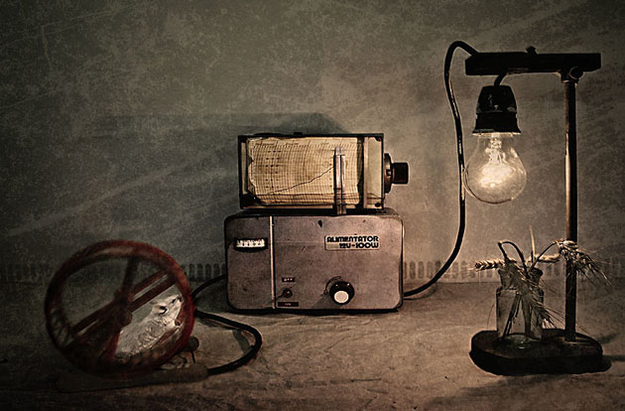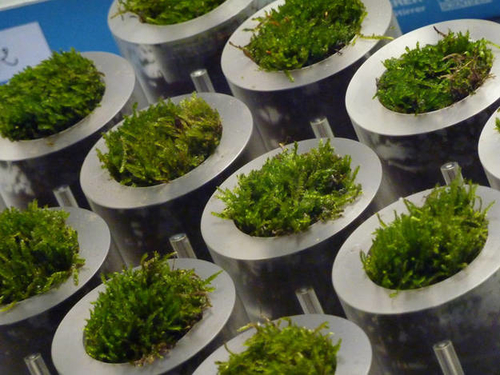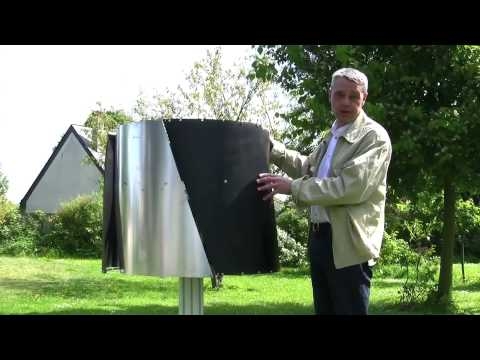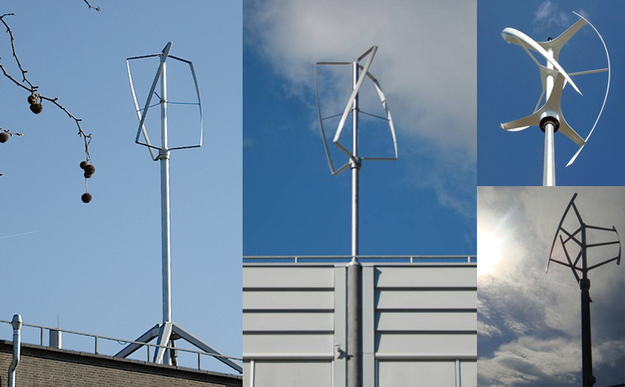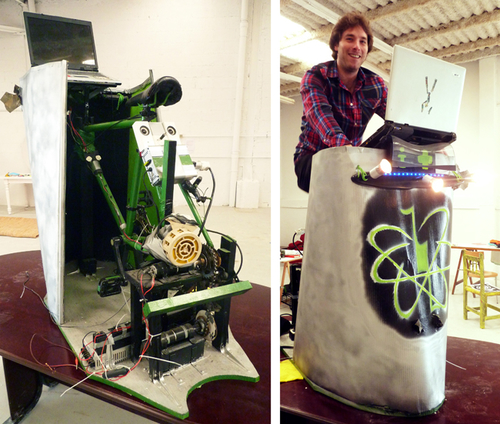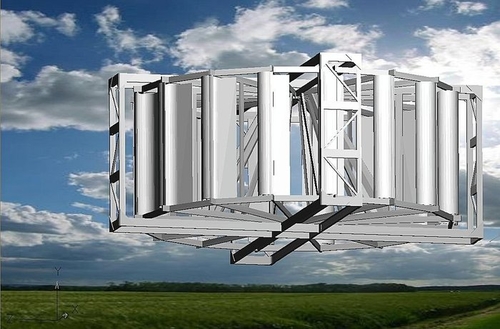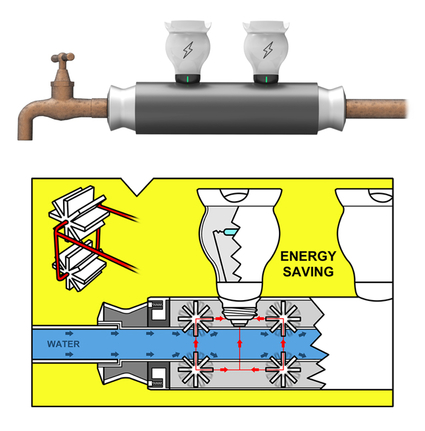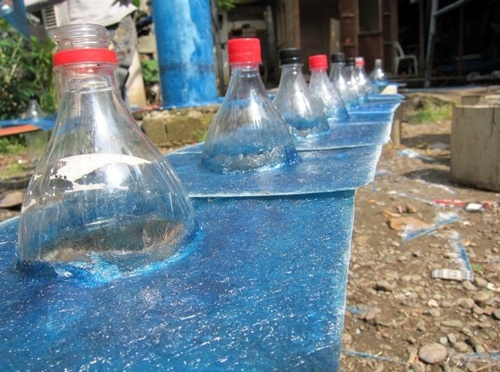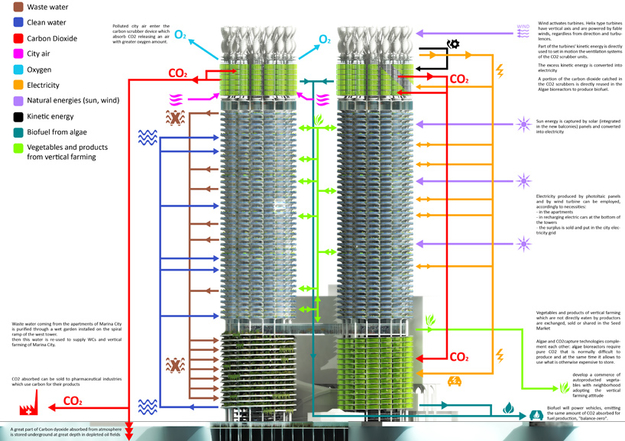Moss Table
Who?
Designers Alex Driver and Carlos Peralta, together with scientist Paolo Bombelli have contributed to this design. All of them are from Cambridge University
What?
They have developed The Moss Table. The Moss Table is a conceptual design intended to demonstrate the potential of Biophotovoltaic technology and how it might be applied in the future.
Why?
Although this is a conceptual design, it gives inspiration for future alternative energy generators.
Read more about the Moss Table here
Vertical axis wind turbine
Who?
This concept was created by the french engineer Patrick Leroy. Information on how to contact Patrick Leroy can be found through the Public Environment Agency of Haute-Normandie or by emailing info@arehn.asso.fr. here
What?
When speaking of wind turbines we usually visualize the massive machines, typically consisting of three blades, that are the main image in national environmental campaigns. Less known are the vertical axis wind turbines which are an innovative alternative for integration into buildings, both as single machines and as collective energy generating sources.
Why?
Available and free energy is all around us, we can even feel it. Creating electricity with wind turbines when a building is located in a windy area is one way to build towards sustainability. It is also the perfect way to be autonomous from the city's electrical grid.
Aerogenerator de eje vertical
Who?
Ecosistema Urbano is an innovative agency focused on the intersections between architecture, urbanism, engineering and sociology.
What?
The Aerogenerador de eje vertical project, roughly translated from Spanish as the vertical axis wind turbine, proposes non-horizontal axis wind turbines where the wind can always be harnessed no matter which direction it blows in.
Why?
Its compact dimensions (2.96 x 2.20m rotor) are completely removable and transportable so it could be an option to place at the Fabriek to use the wind as green energy.
Subestación energética por pedaleo
Who?
This project is by the Spanish designer Gorka Peña
What?
Subestación energética por pedaleo, roughly translated from Spanish as the 'pedal power substation', is a tool to store energy while you exercise. Equipped with a battery to store the energy you can be fit and be green at the same time.
Why?
The Dutch love to cycle, so why not harness some of that energy and use it at the Fabriek to power our space. This is a good way to get our visitors involved in powering the Fabriek.
This project was found on Inteligencias Colectivasm, and more can be read about it Inteligencias Colectivas here.
Vertical Axis Wind Turbine
Who?
This is a project conceptualized and created by Eliogir, an environmentalist engineering company which integrates vertical axis turbines in urban architecture.
What?
These turbines are totally adapted to windy places in urban areas. On buildings rooftops, they reuse this local natural resource to create electricity. The turbines' design are also included in the urban architecture.
Why?
Available and free energy is all around us, we can even feel it. Creating electricity with wind turbines when some building is located in a windy area is participating to the global warming issue. And it is also the perfect way to be energetically autonomous.
A Liter of Light
Who?
MIT students in the Philippines found a sustainable way to create light inside of the poorest houses of the Filipinos. They found that a one liter plastic bottle filled with bleach water and installed on top of a metal roof is a surprisingly simple way to light homes that have neither electrical connectivity nor natural lighting.
What?
Plastic bottles filled with bleach and water are inserted into a hole that is cut into the metal roof, and then sealed off; the bleach keeps the water both clear and free of potential germs.
Why?
With just one liter of water, the equivalent of a standard 60 watt light bulb can be installed in less than a hour and works for as long as five years!
EcoBot III
Who?
This robot is developed by the UK’s Bristol Robotics Laboratory. The Bristol Robotics Laboratory carries out cutting edge research programmes focused on the development of autonomous robot systems.
What?
This self-sustaining cyborg is fuelled on dirt, leaves, and excrements, which it converts into electricity. It is an intelligent machine, which is also potty trained (it can get rid of its own waste). With the help of funding from the Bill and Melinda Gates Foundation, the EcoBot will propagate electricity from urine in developing countries. NASA has also noticed its ability to feed off of fecal matter, which could revolutionize life in space.
Read more about the EcoBot III here.
Why?
Aside from the marriage of sustainability and new technologies, which we are definite fans of, the very process of generating electricity from waste and fecal matter is of special interest to future projects at the Fabriek. We always need electrical energy and new ways to get rid of the waste that will be generated everyday in our space.
ES Pipe Waterwheel
Who?
Designed by Korean innovator Ryan Jongwoo Choi, the ES Pipe Waterwheel is an independent system that contains mini turbines which generate power from flowing water
What?
It is easy to use and install. The ES Pipe Waterwheel can be placed along practically any length of water pumping piping. The waterwheel system then generates power every time someone turns on the tap for a drink of water or a shower, energy which can then be stored for future use or implemented straight away.
Why?
Mediamatic is looking forward to discover elements that generate power from everyday activities, which have the potential to change the world. And the ES Pipe Waterwheel is a simple system that allows you to generate energy every time you turn on the tap.
Algae green loop
Who?
Paris-based architecture office influx_studio
What?
Algae green loop recognizing the growing need for a new sustainable model in the city, the retrofitting design seeks to achieve zero environmental footprint by introducing algae technology on to pre-existing structures.
Why?
It explores ways of urban decarbonization by integrating loops of bioreactors.
